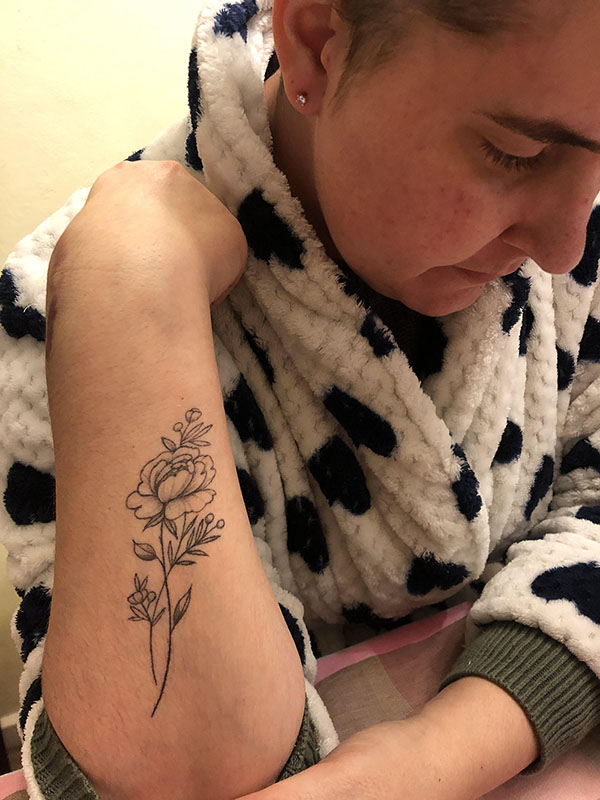Daniela’s Story
In April 2021 Daniela, or Dee as we affectionately called her, was diagnosed with aggressive brain cancer.
Dee had led a healthy, fit lifestyle. In addition to half-marathons and triathlons, she participated in fundraising bike rides, went to the gym, and got out as much as she could. She loved escaping to Perth’s beautiful beaches, often visiting her favourite, City Beach and also taking her beloved Rhodesian Ridgeback Louie, to the many dog beaches.
Dee had suffered migraines since her teenage years, but she had developed strategies that managed to keep them at bay as much as possible. In the months before her diagnosis, Dee felt unusually tired and her migraines became more frequent. Despite this, and unaware that her headaches were an indication of anything more sinister, Dee continued to stay active. However, one day while out walking with friends, she noticed her right foot just catching the footpath. A visit to the GP and a CT scan quickly followed to rule out a stroke. Things escalated quickly however, with Dee being admitted to hospital for further tests and an MRI, confirming the presence of brain cancer.
Before we knew it, there were appointments with an oncologist and neurosurgeon, and three days later, Dee was admitted to hospital for an open biopsy, or craniotomy. The neurosurgeon said it was an aggressive form of brain cancer and unfortunately he was unable to surgically reduce the size of the tumour. Biopsy results a week later showed Dee had an astrocytoma with a WHO grade of at least III. This astrocytoma, we learned months later, would develop into glioblastoma, the most aggressive type of brain cancer. Dee also had two other tumours that were located deep in her brain, meaning all three tumours were inoperable.

And so began the journey. Shock, tears, fear and Google, searching for answers to every question we forgot to ask the oncologist. Working our way through the confusing pathology reports, trying to decipher what IDH1 or IDH2 variants actually were, and what hypermethylation and wildtype meant. How would chemo and radiation treatments affect Dee’s body? Were there any trials or alternate treatment options available anywhere in the world? There was nothing positive to read about brain cancer, particularly glioblastoma. The words were brutal and confronting. Yes there were trials, but not in Australia, and we learned that the treatments for brain cancer had been the same for 30 years. Nothing had changed in all that time, including the survival rate.
Through May and June, Dee underwent six weeks of chemo and radiation, and we hoped with everything we had that the treatment would save her. As expected, the chemo made Dee nauseous, the aggressive radiation made her extremely tired, and she lost almost all of her beautiful hair. These side effects were mild however, compared to the swelling the biopsy had caused to Dee’s brain, temporarily paralysing the right side of her body. Fortunately, this was alleviated with steroids. However, it was the start of a slippery slope. Dee needed more and more steroids to keep paralysis at bay and they came with their own side effects.
Once Dee was through the chemo and radiation, we had to wait an anxious four weeks for another MRI to see if the treatment had worked. In the meantime, Dee felt reasonably well and got on with life, even taking a short holiday in Broome.

The follow-up MRI showed that the treatment had stopped tumour growth, so we were cautiously hopeful. The next MRI was inconclusive, with results unclear whether the tumour had stopped or showed signs of pseudo-progression, another new term we had to learn about. In November however, the next MRI brought the devastating news that the tumour had progressed.
On 8 December, Dee and her partner Taylor relocated to Canberra, where she was born, to be with her family.
Dee had two more stays in hospital, but in February her condition began to deteriorate rapidly and her oncologist prepared us for what was to come. He encouraged us to take Dee home. At that point, her movement was severely restricted and she could no longer speak.
It was a sad homecoming. We converted the lounge room into Dee’s makeshift hospital room, determined to look after her ourselves. Dee knew she was home, surrounded by family, friends and so much love. We could see in her eyes that she was glad to be home and she loved us too. With the help and support of the amazing nurses and carers who visited daily, and with heavy hearts, we began palliative care.
Dee fought the battle with everything she had; she stayed strong throughout the aggressive treatments, and was brave above all odds, right to the end. But tragically, at 4:00 a.m. on March 21, 2022, only 11 months after diagnosis, our beautiful, brave Dee lost her battle. She was just 34.

Love Life
A favourite sloppy joe of Dee’s featured the words “Love Life”. And she did. Dee was happy, vivacious and sassy, and she lived life to the fullest. She was positive and embraced every opportunity. Her beautiful spirit rippled through the lives of all who knew her. It touched them with her love and warmth, bringing people together and lifting the hearts and minds of those around her. She was truly remarkable.

The Peony Rose
Dee had a striking peony rose tattoo on her right arm, and we have worked this design into Dee’s story. It has become an eternal reminder to us of the amazing person she was.

